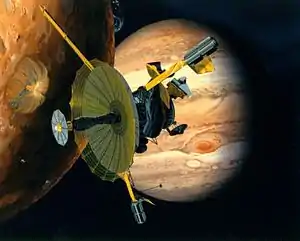Galileo (spacecraft)
Galileo was an unmanned NASA spacecraft. It explored the planet Jupiter and its moons. Galileo was launched in 1989 and it arrived at Jupiter in 1995.
 Artist's concept of Galileo at Io with Jupiter in the background; the high-gain antenna is fully deployed | |||||||||||||||||||||||
| Names | Jupiter Orbiter Probe | ||||||||||||||||||||||
|---|---|---|---|---|---|---|---|---|---|---|---|---|---|---|---|---|---|---|---|---|---|---|---|
| Mission type | Jupiter orbiter | ||||||||||||||||||||||
| Operator | NASA | ||||||||||||||||||||||
| COSPAR ID | 1989-084B | ||||||||||||||||||||||
| SATCAT no. | 20298 | ||||||||||||||||||||||
| Website | solarsystem | ||||||||||||||||||||||
| Mission duration |
| ||||||||||||||||||||||
| Distance travelled | 4,631,778,000 km (2.88 billion mi)[1] | ||||||||||||||||||||||
| Spacecraft properties | |||||||||||||||||||||||
| Manufacturer |
| ||||||||||||||||||||||
| Launch mass | |||||||||||||||||||||||
| Dry mass | |||||||||||||||||||||||
| Payload mass | |||||||||||||||||||||||
| Power | |||||||||||||||||||||||
| Start of mission | |||||||||||||||||||||||
| Launch date | October 18, 1989, 16:53:40 UTC[3] | ||||||||||||||||||||||
| Rocket | Space Shuttle Atlantis STS-34 / IUS | ||||||||||||||||||||||
| Launch site | Kennedy LC-39B | ||||||||||||||||||||||
| Entered service | December 8, 1995, 01:16 UTC SCET[4] | ||||||||||||||||||||||
| End of mission | |||||||||||||||||||||||
| Disposal | Controlled entry into Jupiter | ||||||||||||||||||||||
| Decay date | September 21, 2003, 18:57:18 GMT SCET; September 21, 2003, 19:49:36 GMT ERT[1] | ||||||||||||||||||||||
| Jupiter orbiter | |||||||||||||||||||||||
| Spacecraft component | Orbiter | ||||||||||||||||||||||
| Orbital insertion | December 8, 1995, 01:16 UTC SCET[4] | ||||||||||||||||||||||
| Jupiter atmospheric probe | |||||||||||||||||||||||
| Spacecraft component | Probe | ||||||||||||||||||||||
| Atmospheric entry | December 7, 1995, 22:04 UTC SCET[4] | ||||||||||||||||||||||
| Impact site | 06°05′N 04°04′W at entry interface | ||||||||||||||||||||||
| |||||||||||||||||||||||

NASA Flagship Program | |||||||||||||||||||||||
Galileo was made up of two parts: an orbiter and a probe. The probe was released from the orbiter on July 13, 1995 and it went towards Jupiter.[5][6] It reached Jupiter on December 7, 1995 and went down into the atmosphere.[5][6] The probe gathered data for 57 minutes until the great atmospheric heat and pressure destroyed it.[5][6]
The orbiter went into orbit around the planet on December 8, 1995[5] and went down into Jupiter's atmosphere and was crushed on September 21, 2003.[7]
References
- "The Final Day on Galileo - Sunday, September 21, 2003". NASA / Jet Propulsion Laboratory via Spaceref.com. September 19, 2003. Retrieved December 18, 2016.
- "Galileo Jupiter Arrival" (PDF) (Press Kit). NASA / Jet Propulsion Laboratory. December 1995.
- Beyer, P. E.; O'Connor, R. C.; Mudgway, D. J. (May 15, 1992). "Galileo Early Cruise, Including Venus, First Earth, and Gaspra Encounters" (PDF). The Telecommunications and Data Acquisition Report. NASA / Jet Propulsion Laboratory: 265–281. TDA Progress Report 42-109.
- D'Amario, Louis A.; Bright, Larry E.; Wolf, Aron A. (May 1992). "Galileo Trajectory Design". Space Science Reviews. 60 (1–4): 23–78. Bibcode:1992SSRv...60...23D. doi:10.1007/BF00216849. S2CID 122388506.
- "NASA: Solar System Exploration: Missions: By Target: Jupiter: Past: Galileo". NASA. Archived from the original on 2012-10-06. Retrieved 2011-03-29.
- "Galileo". Encyclopædia Britannica Deluxe Edition. Encyclopædia Britannica. 2005.
- "NASA: Solar System Exploration: Galileo Legacy Site". NASA. Archived from the original on 2006-10-02. Retrieved 2011-03-29.
Wikimedia Commons has media related to Galileo mission.
This article is issued from Wikipedia. The text is licensed under Creative Commons - Attribution - Sharealike. Additional terms may apply for the media files.